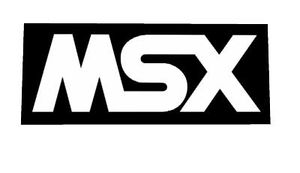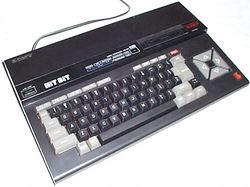MSX
From C64-Wiki
Jump to navigationJump to search
|
This article is very short and not very detailed. Please help to improve it. |
The label and home computer standard MSX (short for "Machines with Software eXchangeability") was an idea for a standard by the companies ASCII Corporation and Microsoft, which are look about of the first MSX home computer Spectravideo SVI-328 and was introduced on 16. July 1983. After Microsoft joined in this project the standard was incorrect called "MicroSoft Extended". The main destination was to get program compatibility to all home computer with MS standard and standards of hard- and software.
Technical Standard[edit | edit source]
Interfaces[edit | edit source]
- 2 autonomous cartridge ports
- 2 joystick ports (Atari-Standard)
- Centronics interface for connecting external pheriphals, e.g. printer
- separate video ports for connecting TV or monitor
- Audio out
- DIN tape port
Mainboard[edit | edit source]
- CPU: Z80 with 3,58 MHz clock rate
- Memory: 8 - 64 KByte RAM, 16 KByte Video-RAM
- ROM: 32 KByte
- Graphic: TMS9918 (Texas Instruments)
- Sound: AY-3-8910 (General Instruments)
- OS: MSX-BASIC, MSX-DOS
MSX home computers (selection)[edit | edit source]
MSX 1[edit | edit source]
- Canon V-20 (1984)
- Daewoo DPC100 (1984)
- Daewoo DPC200 (1984)
- Fujitsu FM-X (198?)
- Hitachi H1 (1984)
- Goldstar FC200 (1984)
- Mitsubishi ML8000 (198?)
- Philips VG-8010 (1985)
- Philips VG-8020 (198?)
- Samsung SPC800 (198?)
- Sanyo MPC5 (198?)
- Sanyo MPC64 (1985)
- Sanyo MPC-X (198?)
- Sony Hit Bit HB-55P (1984)
- Sony Hit Bit HB-75P (1984)
- Sony Hit Bit HB-201P (1985)
- Spectravideo SVI-728 (1984)
- Toshiba HX-10 (1984)
- Yamaha CX5M (1985)
- Yashica YC-64 (1984)
MSX 2[edit | edit source]
- Philips VG-8235 (1986)
- Philips NMS-8245 (1986)
- Philips NMS-8250 (1986)
- Philips NMS-8280 (1987)
Links[edit | edit source]
| Wikipedia: MSX |

